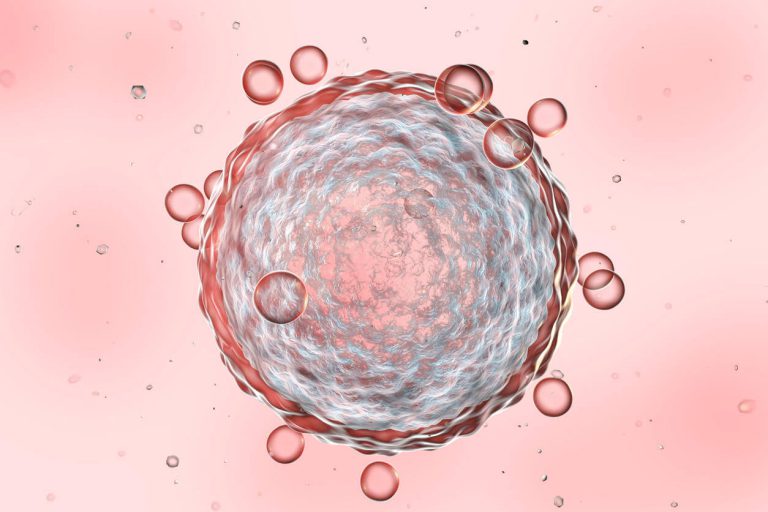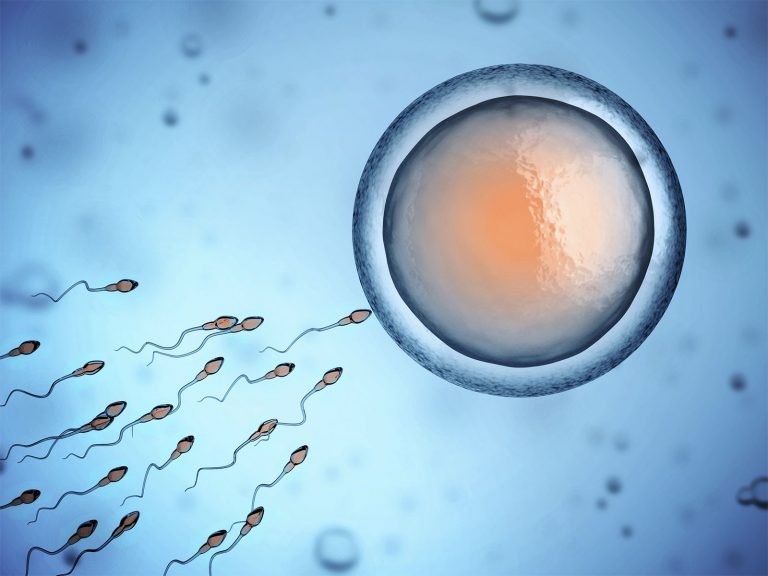Endometriosis, or “endo”, is a common yet painful chronic disorder in which the endometrium (the tissue that lines the uterus) grows in other areas outside the uterus. Most commonly, this misplaced tissue might grow in or around the ovaries, fallopian tubes, and pelvis. There is a newly developed non-surgical genetic test for endometriosis and related conditions that interfere with embryo implantation.
What is Endometriosis?
Normally, the endometrium’s job in the uterus is to act as a nutrient-filled “bed” to nourish any potential pregnancy that might implant in the uterine wall. Every month, this lining thickens and fills with blood, and if no pregnancy occurs, then the lining breaks down and is shed every 28 days through the cervix and out the vagina during the menstrual cycle, or period. This cycle, on a very general level, is to build the lining, wait for an embryo to implant, or shed the lining if no baby is recognized, and this process is repeated during the reproductive years of a woman.
However, when a woman has endometriosis, the misplaced endometrial tissue growing outside the uterus has no way to leave the body like a normal menstrual cycle. Over time, this can cause swelling and irritation of the surrounding tissue and organs, causing painful periods, and potentially a buildup of scar tissue which can affect fertility if left untreated.
How Common is Endometriosis?
Endometriosis is a common disorder that affects 10% of childbearing age women in the United States. In the U.S. alone, endo affects about 5 million women and results in an annual loss of $119 billion in work place productivity. Worldwide, an estimated 176 million women battle this neglected disease, often suffering in silence for years. Despite such a high rate of prevalence, research on endometriosis is very limited.
Symptoms of Endometriosis
Endometriosis symptoms are caused by the misplaced buildup of blood and tissue in areas outside of the uterus and is often very painful. Research shows that on average, this painful disorder causes women to lose 10 hours of work per week. Interestingly, many women do not have symptoms at all – at least initially – but when they do start to occur, they might include:
– pelvic pain which gets worse during your period (dysmenorrhea)
– heavy bleeding during your period
– bleeding between periods
– painful sexual intercourse (dyspareunia)
– painful bowel movements or urination
– infertility

How is Endometriosis Diagnosed?
One of the biggest challenges facing endometriosis is how it is diagnosed. Currently, the only way to officially diagnose endometriosis is through laparoscopic surgery. An alternative and less invasive approach is a newly developed genetic test called ReceptivaDxTM , which can test for the inflammatory biomarker BCL6 and Beta-3 integrin. Laparoscopic surgery is done under general anesthesia and allows for the doctor to view the endometriosis directly by inserting a pencil thin camera into the abdominal area to make a definitive diagnosis by visual observation of the tissue. However, on average, it takes 7-10 years before a woman is diagnosed with endometriosis formally through surgery.
The current standards in place result in a delayed time to care, causing fertility and health problems that otherwise could have been minimized or avoided all together. So why are women suffering for 7-10 years before being formally diagnosed and treated for endo? Some physicians have acknowledged that doctors of both genders generally don’t take women’s pain as seriously as they would for men. John Guillebaud, professor of reproductive health at University College London, tells Quartz that he believes doctors of both genders underestimate the pain of endometriosis:
“On the one hand, men don’t suffer the pain and underestimate how much it is or can be in some women. But I think some women doctors can be a bit unsympathetic because either they don’t get it themselves or if they do get it they think, ‘Well I can live with it, so can my patient.'”
Michelle B., author at ENDOhope.com and endo patient, shared similar sentiments to Guillebaud and how she had to see six different doctors over 7 years to finally get diagnosed through laporoscopic surgery. Contrary to Guillebaud, Michelle mentioned that it was a male physician who diagnosed her with endometriosis and that she attributes her positive experience to the fact that this physician actually listened to her without making any assumptions.
Whether it is the subjective rating of pain that varies person to person, or the lack of awareness surrounding endometriosis, it is clear that women are suffering for years without being taken seriously. Although endo can be diagnosed, the invasive nature of this method combined with the likelihood that physicians underestimate the pain associated with menstruation seems to be just a few reasons why physicians can be reluctant to opt for laparoscopic surgery.
Risk Factors for Endometriosis
Understand the risk factors to determine whether you’re susceptible for endometriosis and if you should express concern and talk to your doctor.
– Having a mother or sister with endometriosis
– Have menstrual cycles that are shorter than 28 days
– Having heavy periods that last more than 7 days
– Never having been pregnant
– Having started menstruation before age 12
– Having a high body fat percentage
– Having higher levels of estrogen in your body
What Causes Endometriosis?
The exact cause(s) of endometriosis are not well understood. It is likely that endometriosis often results from more than one cause. We know that the hormone estrogen is involved and There are three theories for the cause of endometriosis.
* Retrograde Menstruation Theory – This is the oldest and most widely accepted theory which was proposed by John A. Sampson in 1921. The retrograde menstruation theory posits that some endometrial cells/debris flow backwards (hence the prefix “retro” meaning to go backwards) into the fallopian tubes, ovaries, and out further into the pelvis. The sloughed off endometrial cells are believed to implant and develop into endometriosis. It’s interesting to note that retrograde menstruation occurs in 76%-90% of women, yet not all of these women have endometriosis. However, research shows women with endometriosis have larger volumes of retrograde menstrual flow compared to unaffected women.
Lymphatic Dissemination Theory – Another theory posited by Sampson which suggests that endometrial cells spread to abnormal places via the lymphatic and vascular system. This hypothesis provides a reasonable theory for why endometriosis is found in distant sites outside the pelvis, like the brain, lung, lymph nodes, extremities, and the abdominal wall.
Coelomic Metaplasia Theory – This theory surrounds the idea that some stimulus, whether it’s genetic, hormonal (estrogen), infectious, or environmental, acts on the non-endometrial tissue and induces a metaplasia, or “change”, into endometrial tissue. However, conclusive proof for the metaplasia theory remains elusive.
Treatments for Endometriosis
Although there is no cure for endometriosis, it can usually be treated effectively. Endometriosis treatment typically involves some combination of medication and/or surgery. Generally, for mild cases, pain medications and NSAIDs (non-steriodal anti-inflammatory drugs) are prescribed to help with pain. If these medications are not sufficient to control the pain, doctors may prescribe hormonal treatments to lower your body’s estrogen levels.
If you aren’t planning to get pregnant, birth control pills are often used to treat endometriosis. If these aren’t strong enough to control your symptoms, more potent hormonal medications may be used, like GnRH agonists (Lupron, Synarel, Zoladex), which block female hormones and antagonists, progestin therapy, or Danazol. These all have the effect of preventing menstruation, and thus are not good treatments for women who want to become pregnant.
Endometriosis is Significantly Associated With Infertility
Although many people think pain is the first symptom of endometriosis, infertility is actually the first symptom of endometriosis that a woman notices.
Between 20% and 40% of women who are infertile have endometriosis.
It is not completely clear why endometriosis reduces fertility in women, but experts think a combination of physical and hormonal factors are at play. Inflammation and scar tissue can make it difficult anatomically for a uterus to achieve or sustain a pregnancy. One California based company, CiceroDX, has created a new genetic test, ReceptivaDxTM , that analyzes a small endometrial biopsy looking for the BCL6 and Beta-3 integrin biomarker. This test is especially useful in women with unexplained IVF failure or infertility.
Another known factor for decreased fertility is the occurrence of ovarian endometriomas, or “chocolate cysts”, in advanced endometriosis (stage 3-4) patients. These “chocolate cysts” affect 17%-44% of women with endometriosis and physically interfere with ovulation and egg/embryo transportation.
Fortunately, it is estimated that as many as 70% of women with mild or moderate endometriosis (stage 1-2) will be able to conceive naturally (without specific fertility treatments) within three years.
Fertility Treatments For Endometriosis
Laparoscopic surgery – When a woman with endometriosis wants to become pregnant, one treatment option is laparoscopic surgery, in which a small incision is made in the abdomen and as much of the endometrial tissue as possible is removed. For those with early endometriosis (stage 1-2), laparoscopic surgery can successfully increase pregnancy rates from 2% to 5%. However, laparoscopic surgery is less effective in advanced (stage 3-4) endometriosis.
IUI + Fertility Medications – For those with early endometriosis (stage 1-2), fertility drugs combined with intrauterine insemination has been shown to increase pregnancy rates from 2% to 11%.
IVF + Fertility Medications – If a more aggressive approach is required, doctors may recommend turning to assisted reproductive technologies like IVF (in-vitro fertilization) to help you become pregnant. Although pregnancies naturally occur among women with endometriosis, pregnancy rates are far superior when IVF treatment is utilized.







